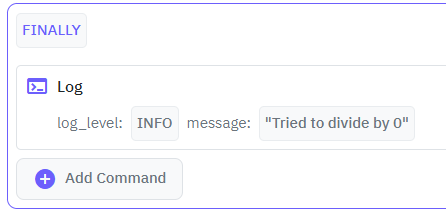When building applications with Twidget, you may encounter situations where you need to handle errors gracefully to ensure your application runs smoothly. Twidget provides two powerful commands for error handling: try-catch and throw-error. This documentation will guide you on how to use these commands effectively.
-
try-catchThe try-catch command is used to handle exceptions that may occur during the execution of your application. This command allows you to execute a block of commands (try block) and provide a mechanism to handle any exceptions (catch block).

The try block will automatically create an error variable, this variable holds the error message and sometimes other information.

Optionally, you can include a finally block to execute code regardless of whether an exception was thrown or not.

throw-errorThe throw-error command is used to explicitly throw an error in your application. This can be useful if you want to enforce certain conditions and notify that something went wrong when those conditions are not met.

try-catch: A command to handle exceptions, execute commands conditionally on error, and optionally run final commands regardless of error outcome.
throw-error: A command to explicitly throw an error, which can then be caught and handled using try-catch.
By utilizing these error commands, you can ensure your Twidget application handles errors gracefully and continues to provide a smooth user experience.
Date
Twidget offers a variety of commands to manipulate date objects. Below are the available commands along with their respective descriptions, inputs, and outputs. Current Date. Description: Returns the current date and time. Output: - Type: DATE Add Time. Description: Returns the date plus a specified...
Conversion
Overview. Twidget's conversion commands allow you to easily convert different data types to the required format. Below is a list of the available conversion commands and examples of how to use them. The `Convert to Text` command converts the provided value to a text (string) format. Examples: - `123...
Connector Commands
Connector Commands allow you to integrate Twidget projects with external services such as Google Drive, Slack, OpenAI’s ChatGPT, and many others. These commands provide ready-made actions that communicate with third-party APIs, removing the need to manually create and maintain external HTTP requests...
Managing Files
Twidget offers a set of commands to manipulate files in your file store. Below are the descriptions and usage of each command to help you understand how to utilize them effectively. Get File. Retrieve a file via file path. Inputs: - `path`: The file path to retrieve the file from. Outputs: - `filena...
Local Storage
Twidget provides a set of local storage commands that enable interaction with the browser’s `localStorage` API through a no-code interface. These commands are useful for storing, retrieving, and managing key-value data persistently within the current domain context. Purpose. These commands abstract ...